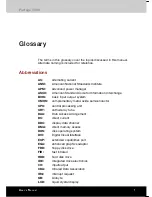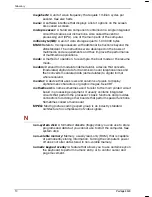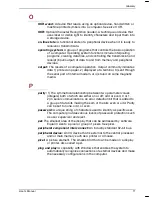
Glossary
8
Portégé 3500
,
hard disk drive (HDD):
An electromechanical device that reads and
writes a hard disk.
See also
hard disk.
hard disk:
A non-removable disk usually referred to as drive C. The
factory installs this disk and only a trained engineer can remove it
for servicing. Also called fixed disk.
hardware:
The physical electronic and mechanical components of a
computer system: typically, the computer itself, external disk
drives, etc.
See also
software and firmware.
hertz:
A unit of wave frequency that equals one cycle per second.
hexadecimal:
The base 16 numbering system composed of the digits 0
through 9 and the letters A, B, C, D, E, and F.
host computer:
The computer that controls, regulates, and transmits
information to a device or another computer.
hot dock/undock:
Connecting or disconnecting a device to or from the
computer while the computer’s power is turned on.
hotkey:
The computer’s feature in which certain keys in combination with
the extended function key,
Fn
, can be used to set system
parameters, such as speaker volume.
HW Setup:
A TOSHIBA utility that lets you set the parameters for various
hardware components.
-
I/O devices:
Equipment used to communicate with the computer and
transfer data to and from it.
I/O:
Input/output. Refers to acceptance and transfer of data to and from a
computer.
icon:
A small graphic image displayed on the screen or in the indicator
panel. In Windows, an icon represents an object that the user can
manipulate.
infrared port:
A cableless communications capable of using infrared
signals to send serial data.
input:
The data or instructions you provide to a computer, communication
device or other peripheral device from the keyboard or external or
internal storage devices. The data sent (or output) by the sending
computer is input for the receiving computer.
instruction:
Statements or commands that specify how to perform a
particular task.
interface:
1) Hardware and/or software components of a system used
specifically to connect one system or device to another. 2) To
physically connect one system or device to another to exchange
information. 3) The point of contact between user, the computer,
and the program, for example, the keyboard or a menu.
Summary of Contents for Portege 3500
Page 1: ...Portégé 3500 User s Manual i 3500 Portable Personal Computer User s Manual ...
Page 172: ...Keyboard Layouts User s Manual D 1 TTIRHM I FSEVH 0E SYXW Belgian 4SVXÃKÃ 9WIVkW 1ERYEP ...
Page 173: ...Keyboard Layouts D 2 Portégé 3500 Danish French ...
Page 174: ...Keyboard Layouts User s Manual D 3 German Italian ...
Page 175: ...Keyboard Layouts D 4 Portégé 3500 Norwegian Spanish ...
Page 176: ...Keyboard Layouts User s Manual D 5 Swedish Swiss German ...
Page 177: ...Keyboard Layouts D 6 Portégé 3500 UK English US English ...
Page 186: ...ASCII Character Codes G 2 Portégé 3500 ...
Page 187: ...ASCII Character Codes User s Manual G 3 ...
Page 188: ...ASCII Character Codes G 4 Portégé 3500 ...
Page 189: ...ASCII Character Codes User s Manual G 5 ...











































